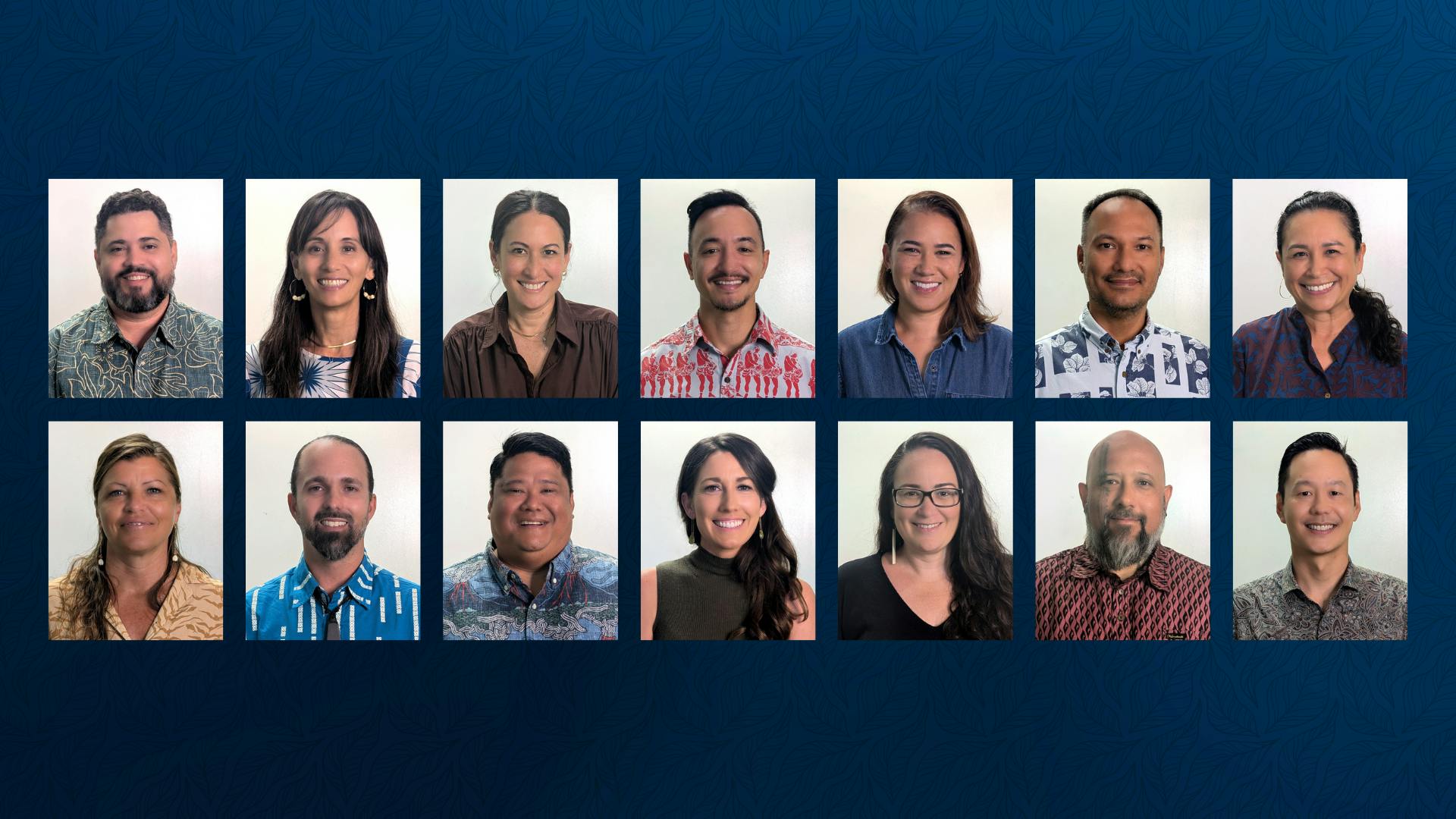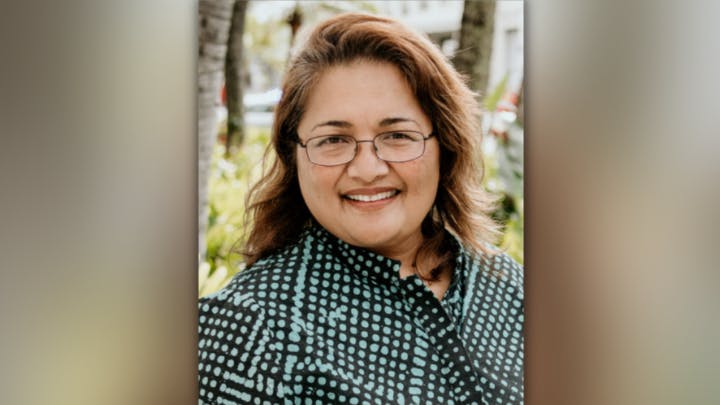
Omidyar Fellows Cohort X
Top row (L to R): Kimo Carvalho, Noe Goodyear-Ka‘ōpua, Michelle Jaime, Ryan Kanaka‘ole, Ku‘ulani Keohokalole, Olin Lagon, Kelly Miyamura
Bottom row: Autumn Ness, No‘eau Peralto, Kaipo Perez III, Liza Ryan Gill, Rebecca Soon, Babā Yim, Terence Young
In this issue of Taking on Tomorrow, we introduce you to fourteen leaders who are our newest members to the Omidyar Fellows program. ‘O Hawai‘i ku‘u ‘āina kilohana. As you’ll read, Hawai‘i holds a special kuleana for each of these leaders. Now, together they will uplift a collective responsibility to our beloved Hawai‘i.
We welcome you fondly, Cohort X!
Me ke aloha,
Cheryl Ka‘uhane Lupenui
Omidyar Fellows Cohort X Lead
Kimo Carvalho
HomeAid Hawai‘i
Which ahupuaʻa do you feel most connected to, and how has it shaped your journey?
While many see a volcano only as a force of destruction, I’ve always viewed it as a source of energy and authentic renewal. That’s why the ahupua‘a I feel most deeply connected to is Kea‘au, one of my hometowns on the Big Island.
From the volcano, through the forests, and down to the ocean cliffs, this place has been a teacher that’s shaped my values, grounding my spirit, and guiding my way of life. Kea‘au continues to influence who I am, what I believe in, how I show up professionally, and how I represent myself in the world—rooted in the resilience and renewal that this place embodies.
Noelani Goodyear-Kaʻōpua
University of Hawaiʻi at Mānoa, Kamehameha Schools
What is a favorite childhood memory that is connected to ʻāina?
As a child, I loved walking our dog, Koala, with my parents in the shallows of Kāneʻohe Bay. We entered through a tunnel in the thick mangrove behind King Intermediate. Koala bounded off through knee-deep waters; I tried to keep up with her. We sniffed squishy-bodied loli. We tasted seaweeds.
Once, we stumbled upon an old rock wall. Filled with wonder, I asked my parents, “Who built this? What’s it for?” They could only guess. Years later, I learned it was a kuapā, a fragment of the wall of an ancestral loko iʻa, untended for many years. Thanks to the work of Paepae o Heʻeia, this fishpond now lives again.
Michelle Jaime
The Vanguard Theory
How do you practice aloha ʻāina in daily life?
I practice aloha ʻāina in daily life by nurturing my relationship with the land and community around me. At home in Pālolo, my husband and I care for a small lei garden and fruit trees, which we share with neighbors as a way of giving back.
In my work as a designer, I practice aloha ʻāina by choosing sustainable materials, supporting local makers, and creating spaces that reflect and respect Hawaiʻi’s culture and environment. For me, aloha ʻāina is both a personal commitment and a professional responsibility—to live with gratitude for the land and to design in ways that ensure its health for future generations.
Ryan Kanakaʻole
State of Hawaiʻi Department of Land and Natural Resources
What native plant do you wish more people knew about and why?
Most people know the importance of māmane in Hawaiʻi’s alpine forests, especially in supporting endangered palila (a finch-billed Hawaiian honeycreeper). Māmane is one of my favorite plants (and the name of my hiapo).
But less understood is the critical role of naio. Fledgling palila rely on naio as a food source, yet these trees are being devastated by invasive thrips. We often emphasize māmane conservation, but without protecting naio, palila populations will continue to decline. There is a critical need to raise awareness of naio’s importance to our native ecosystems and to invest in efforts to stop the spread of naio thrips.
Ku‘ulani Keohokalole
People Strategies Hawaiʻi
What is a favorite childhood memory that is connected to ʻāina?
During the summer, our whole extended family—led by my Grandmother, my mother’s mother—spent time together, which either involved playing with the creatures in the tidepools at Turtle Bay in Kūʻilima, or camping in tents at Bellows in Waimānalo.
If it was Bellows, no matter what, we would always get stung by Portuguese man o’ war at least once. It was sort of a rite of passage for all us kids. When I think about those summers, I equate being outdoors and on ʻāina with spending meaningful time together as one ʻohana, with all the aunties, uncles, and cousins.
Olin Lagon
Shifted Energy
Which ahupuaʻa do you feel most connected to, and how has it shaped your journey?
Right now, it’s Heʻeia. My connection there is less about genealogy and more about presence. For years, I have gone to mālama kalo on weekends. I’ve always loved to learn about everything, but as a keiki that curiosity often felt like restlessness, and staying focused was a constant struggle.
The loʻi has become a place where I can process a firehose of ideas and information. I find a rhythm that quiets me, where I stumble into connections I might otherwise miss. I often leave the loʻi lighter, carrying energy from my kūpuna that I did not arrive with.
Kelly Miyamura
The Harry and Jeanette Weinberg Foundation
What native plant do you wish more people knew about and why?
‘A‘ali‘i. This year, I started making lei from ‘a‘ali‘i, and learned it can also be used in tool making, as medicine, and as dye. It can thrive in diverse climates from lava to high elevation to dry forests, and is wind and drought resistant. It’s such a useful plant, and its resilience captured in the Ōlelo No‘eau: He ʻaʻaliʻi kū makani mai au; ʻaʻohe makani nāna e kulaʻi. #507 is so instructive for us today, to be flexible enough to bend in wind, but strong enough to stand firm through adverse conditions.
Autumn Ness
Lahaina Community Land Trust
How do you practice aloha ʻāina in daily life?
I practice aloha ʻāina daily by sourcing local, organically grown food and supporting farmers and ranchers who steward ʻāina responsibly. That’s why we started Maui Hub—to make it easier for more people to do the same.
While there are many ways to aloha ʻāina, I believe the most important action is supporting the return of land to kanaka stewardship and ownership, however possible in today’s system. Creating space and opportunity for their ʻike to lead is the ultimate aloha for this ʻāina. I feel so fortunate that my professional role allows me to contribute directly to this work.
Noʻeau Peralto
Hui Mālama i ke Ala ʻŪlili (huiMAU)
What native plant do you wish more people knew about and why?
I wish more people knew about ʻulu—breadfruit. While it has grown in popularity in the past decade, it is still largely under-appreciated here in Hawaiʻi. Beyond ʻulu being one of my favorite Hawaiian staple crops to eat, I firmly believe that ʻulu can play a critical role in Hawaiʻi’s movement towards future food sovereignty and climate justice. This is a main reason that our Hui chose to center ʻulu in our ʻāina restoration efforts in Koholālele. ʻUlu trees not only feed human communities; they feed microbial communities that build healthy agroforest ecosystems from the soil up.
Kaipo Perez III
ANSER (DoD Contractor) / Hawai‘i Coordination Cell, Office of the Assistant Secretary of Defense for Energy, Installations, and Environment
What is a favorite childhood memory that is connected to ʻāina?
As a child, I remember the first time I gathered limu kohu at Kaiona Beach for my Tūtū. Eager to bring her as much as possible, I grabbed the limu quickly, not realizing I was pulling it out by its roots or holdfast. When she was cleaning it, she noticed and gently explained that removing the roots prevents the limu from growing back. She taught me to pinch and twist carefully, taking only what is needed while leaving the roots intact. This early lesson in mālama ʻāina shaped my lifelong understanding of sustainability and kuleana.
Liza Ryan Gill
Hawaiʻi Coalition for Immigrant Rights
Which ahupuaʻa do you feel most connected to, and how has it shaped your journey?
I feel most connected to the ahupuaʻa of Honouliuli where my family has been caring for Pālehua. In 2019, we moved off-grid up the mountain to learn directly from our kūpuna and the land itself.
Over five years, we came to know every wind, prayed for rain, marveled at the grass growing in spring, and absorbed the mo‘olelo, challenges, and hopes of Pālehua. Like the red lepo that stains everything it touches, this ʻāina has indelibly marked me, shaping how I lead, listen, and care for community and land together.
Rebecca Soon
Solutions Pacific; Ward Research
What native plant do you wish more people knew about and why?
Pōhinahina is a humble yet powerful shrub with beautiful purple flowers. With its deep root systems, it stabilizes sandy soils and helps guard against erosion—an essential role as climate change and historical use of our islands continues to erode many critical habitats.
An almost fuzzy silver, the leaves have a fragrance of sage once used to scent kapa and could have many uses today. Pōhinahina also nurtures coastal ecosystems by providing habitat and shelter for native species. Much like ʻa‘ali‘i, it stands as a metaphor for strength and perseverance, reminding us that beauty and resilience thrive even in harsh conditions.
Babā Yim
Ke Kula Kaiapuni ʻO Ānuenue (Hawai‘i State Department of Education)
What native plant do you wish more people knew about and why?
I wish more people knew about uhiuhi. It is one of, if not the hardest, of all the native woods. I wish more people knew about it because it is a reminder of the genius and ability of our kūpuna. With no modern blades or tools, they were able to collect and shape this incredibly dense hardwood and turn it into implements for daily life like tools, weapons, and especially dear to my cultural practice, implements for kākau uhi or traditional tattooing. It is very rare today and valued by practitioners of many traditional arts, yet it is a wood that not many people ever see with their own eyes.
Terence Young
Hawaiʻi Pacific Health
How do you practice aloha ʻāina in daily life?
Aloha ‘āina has a direct correlation to public health, which bridges both the responsibility of protecting people and tending to our ‘āina and its resources. Caring for the environment is essential to protecting the health of our communities. One of the overall yearly goals at Hawai‘i Pacific Health is sourcing 50% of food produce from local food systems. This supports local farmers, growers, and fisherman, strengthens food security, and promotes healthy eating for the community on a larger scale. Personally, I try to follow this at home and provide my family with clean, local, and sustainable foods.
Hawai‘i News Now — From a small atoll in Micronesia to leading a statewide organization in Hawai‘i, Josie Howard’s journey is one of resilience and humility.
